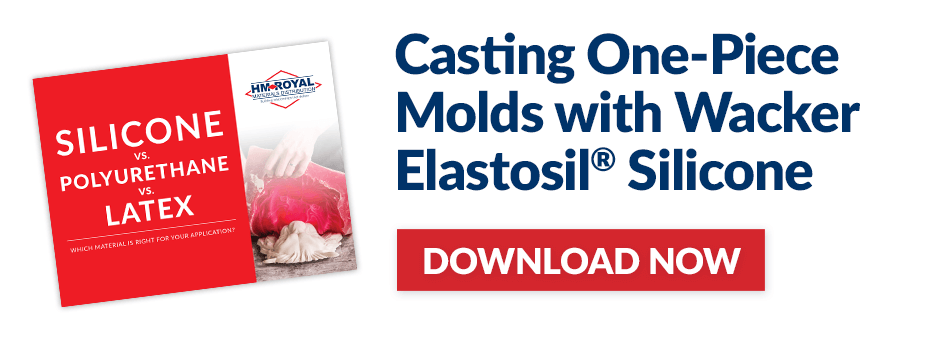Overcoming Top Challenges in RTV Silicone Rubber Mold Making
Reading Time: 3 minutes
Last Updated on February 27, 2025
Due to its performance advantages and versatility, RTV silicone rubber is becoming the preferred choice of many mold makers. It offers a number of benefits for the mold-making process, including excellent thermal resistance and long-lasting flexibility. In addition to mold-making, silicone is widely used in other fields such as bonding, sealing, potting, encapsulation, coating and casting.
When making a silicone rubber mold, certain issues can occur that affect the quality of the finished product. To help you improve the mold-making process, this blog explores potential mold-making issues and how to overcome them.
1) Cure Inhibition
Working with Polyaddition RTV Silicone
Cure inhibition is one of the most common issues that can occur during the mold-making process. Inhibition is when the silicone rubber will not cure. The platinum-based cure system in the silicone rubber can become deactivated by coming in contact with contaminants. Once this occurs, the detail of the reproduction in this area is lost and cannot be reclaimed. The mold will need to be remade.
Inhibition can occur when a platinum-cure silicone rubber comes in contact with any of the following:
- Chlorinated solvents
- Acetone, MEK
- Adhesive tape (e.g., duct tape)
- Coatings, paints, solvent carriers
- Clays containing sulfur (ask the manufacturer for sulfur-free clay)
- Sulfur-cure organic rubber (e.g., neoprene or natural rubber)
- Latex gloves (use latex-free gloves)
- Amines, epoxy, TDI urethanes
- Gel coats
- Bondo
- Polyester paints
- Condensation-cure RTV silicones, silicone or urethane caulking
- Composite pre-preg
Applying silicone rubber over a model that contains or has had contact with any of these materials can result in cure inhibition. The cured rubber mold may appear fine from the outside, but any contaminated areas will remain sticky and not cure. If you use latex gloves in your mold shop, avoid using these gloves in the silicone rubber processing area. Another way to avoid inhibition is to put clean poly film on your work area before you start working with silicone rubber.
Do a Patch Test to Check for Cure Inhibition
When using these materials, or any unknown materials, in combination with polyaddition- (platinum) cure silicone rubbers, it is highly recommended to do a small patch test. This test should be done on a nonobvious spot on the master to check for cure inhibition. Once the silicone rubber cures properly, inhibition will not occur.
Working with Polycondensation-Cured Silicones
If your mold shop works with both polycondensation- (tin) cured silicones and addition- (platinum) cured silicones, you should keep these materials separate from each other. Although both materials are types of silicone, they have very different chemistries. Even small amounts of polycondensation materials in the air can inhibit platinum-cured silicone rubber. To prevent cure inhibition, it is important to keep these materials separate, ideally in separate rooms. You should also use a dedicated set of tools for each material.
2) Degassing and Air Bubbles
If you’re mixing the compounds by hand, you should have a vacuum chamber in your mold shop. Manual mixing with a spatula or a drill with a paint mixer blade can introduce air into the mix. That’s why it’s essential to use a vacuum chamber to remove any air bubbles from the silicone rubber before pouring to make the mold.
For best results, we recommend using a dispensing system and a static mixer rather than hand mixing. If this isn’t an option, the rule of thumb for hand mixing materials under 5,000 CPS in viscosity is to let the material sit for 5-10 minutes so the air bubbles rise to the surface and pop. You should then pour the material in a thin ribbon to prevent introducing air while pouring. For materials that are higher than 5,000 CPS, they can be hand mixed but will not degas on their own, and you must use a degassing chamber or degassing process. For materials higher than 15,000 CPS, they should be mixed using a dispensing system with a static mixer. This closed system will prevent any air intrusion.
H.M. Royal offers a wide range of silicone elastomers from Wacker, including liquid silicone rubber (LSR), room-temperature-vulcanizing (RTV) silicone rubber and high-consistency silicone rubber (HCR). For more information or help selecting the right silicone elastomer for your application, contact us today.







